Where we live–the spaces we inhabit, and how they are designed, make an enormous difference in how we are able to address climate change and sustainability. Modern houses are commonly disconnected both from the land where they are placed but also are constructed of materials that are industrially produced. While these houses go up quickly and offer all the modern amenities that support hectic lifestyles, their materials, construction, and demands for energy and resources do not allow us to address climate change. Here’s an example–I live in a modern house built in the late 1970s. Despite adding a heat pump, solar panels, adding additional insulation, doing an energy audit, and supplementing our heat with two wood stoves, we still manage to consume more electricity in winter for heating. This is not because of any choices we made–quite the opposite–but rather, because the house itself is designed to consume and is built in a way that is not very efficient. Most houses in the world that are built using modern technology are just like this–these houses were built when there was very little concern for how much energy, water, or anything else the house consumed. Modern houses are also much larger than necessary, further contributing to heating and cooling costs–and thus carbon.
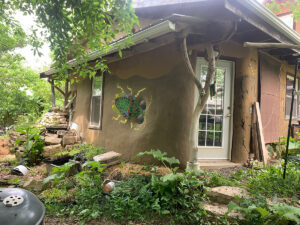
Enter natural building. Natural building works with nature to build structures that are made of natural materials, produced using ecological approaches and produced using the local resources on the land, so you can monitor what is used, how it is used, and so on. Natural buildings include everything from strawbale houses, dugout houses, earthbag construction, rammed earth construction, cordwood construction, and Earthships). They are often very sustainable and also can be literally built by almost anyone with a good deal of time, patience, and simple tools. Natural building is much more forgiving and flexible than traditional building. Traditional building (normal houses) is a specialist profession that requires special tools, specialist knowledge, heavy equipment, toxic and expensive materials, and of course, quite a bit of cash. Natural building is able to be picked up by the generalist and requires simple tools and materials that can be harvested locally and often on-site. But natural building is a very sizable investment in human power and time–because when you aren’t using industrial materials, it takes time and sweat equity to produce a home, shelter, or anything else.
In this post, I’ll review the four-day Natural Building Workshop I had the pleasure of taking at Dancing Rabbit Ecovillage in June 2022, sharing insights about building with nature, surrounded by nature and community. I offered a general review of my time there earlier this year. I also want to point out my earlier natural building posts: Strawbale Studio, Rocket Stoves, and building an Earth Oven Part I and Earth Oven Part 2. It has taken me a while to get back to this post, but I’m happy to share this review in the hopes that others may be interested in learning from Dancing Rabbit!
Naturally Built homes
Dancing Rabbit is unique in that they have a very wide variety of naturally-built structures–one of the largest collections of them anywhere in the US (and possibly the world). Over 40 naturally built homes included a variety of techniques, with many being strawbale/cob, light clay straw, or earthbag. This makes Dancing Rabbit an outstanding place to go learn how to build naturally–and with that approach, you can see the options and how they perform.

One of the things that was stressed during our workshop tours was the importance of the relationship between form and function. How do we create houses that work for us, that are in line with our basic needs, allowing people to live in harmony with nature, simply, and comfortably? It was amazing to see the vast variety of different structures of natural materials–some looking and the size of a regular house to tiny structures that were intimate and very low impact.
Part of what I learned through our Natural Building workshop and modeled so beautifully at Dancing Rabbit as a whole was how important our homes and daily living are for enacting other kinds of sustainable living practices. What we inhabit determines how we live, what we can do, and our impact on the world around us. I originally grew interested in natural building for its empowering, democratic, and ecologically oriented nature. But, some of the naturally built places I’ve visited have often been models rather than real, lived-in places.
Another important consideration was thinking about performance: how does the structure stay cool naturally in the summer, and how well can it retain heat in the winter? Does the home protect the inhabitants from weather extremes? These are critical choices everywhere, but especially at Dancing Rabbit, who has made a community-wide commitment to not using fossil fuels for heating or cooling. And of course, in the age of climate change, extreme weather happens more and more often, making these considerations just smart decision-making strategies. We never know what the next season may bring.
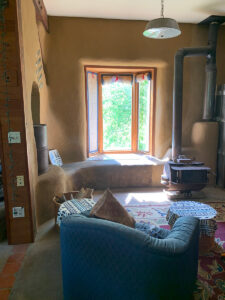
The third consideration that was stressed was learning and growing from one’s mistakes. We looked at several examples of houses and structures that had mistakes in them. One of my favorite houses was solid cob–cob is not insulative (that’s what the strawbales are for). Thus, without insulation, cob is not a good building material in temperate climates. A straight cob house becomes an icebox in the winter months and the walls literally freeze and put out cold. We looked at another house that had a lot of shifting due to the fact that the strawbales weren’t compressed (and they were load-bearing, meaning that they were holding the rafters and the weight of those. These were presented to us not as failures, but as examples to learn from.
Thus, in this specific course, I appreciated the way in which we not only learned about the natural building techniques but also, how we saw the outcomes of those techniques—and how they ultimately changed visitors’ and residents’ interaction with their surroundings. This lesson was demonstrated so powerfully through simply staying in the village but also the multiple tours where we got to tour residences, talk about their winter and summer performance, and see how they functioned in relationship to other sustainable systems (water collection, solar power, heating, permaculture practices, gardens, living roofs, animal husbandry, and more). We got to see how real life people lived in these houses and how they made them into homes. Thus, one of the major lessons was how much our daily living circumstances can facilitate—or hinder—ecologically-based living.
Natural Building: Realistic Expectations, Principles, and Techniques
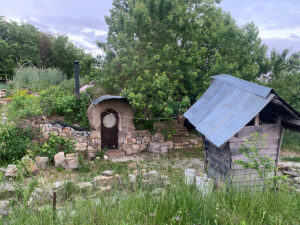
I think one of the things that often shocks people when moving into a natural building (or gardening, or anything else sustainable) is that fossil fuels do incredible amounts of work very quickly. Modern society has made everything that is expedient, and convenient, and almost always, these modern conveniences are very damaging to the planet. As soon as you seek to eliminate fossil fuels and consumptive products from the equation, you have to make up that work with people power. It is not uncommon to spend a year–or more–working on a naturally built home or project. Some of the folks new to natural building were shocked when they heard how long it takes.
For example, with me working on it for 3-4 hours a session about 2-3 times a week (as a solo builder), my earth oven took a full summer to build, and my shelter for the earth oven took me another summer to build. A big part of that process wasn’t the building itself but getting all of the materials to build–getting rocks from the nearby farmer’s rock pile, digging and sifting subsoil to prepare to make into cob, harvesting wood from trees that fell and stripping bark, you get the idea. I also had to take the time, as an animist, to make sure that I was aligning my own intentions with that of my land and that I had permission to take the materials in the first place.
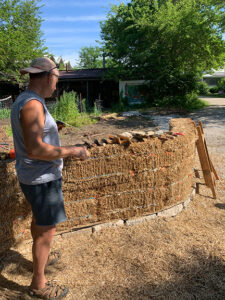
Thus, natural building is on slow time, it is on earth time, and thus, it takes the time it takes. If you want things done quickly, natural building is not the right approach for you. But if you want them done ethically, creatively, and well, then the natural building is a great approach. You just have to be willing to put the time in and recognize that this is serious labor–maybe moe than you are used to.
One of the most important things you are working towards in any building is avoiding change. When you put a structure in, you want it to stay pretty much how you build it–shifting, water damage, etc, all are fights against change. This is part of why it is so critical that any naturally built structure has a good “hat” (roof” and good “feet” (footing, waterproofing, moisture barrier)–natural materials are more susceptible to breaking down in nature faster (cause you know, they are right from nature) so you want to take extra car.
Another core principle for natural building is that this is better done in community than by yourself. You can do builds by yourself (as I mostly did with the earth oven), and I think for small projects, that’s really a fine thing to do. But especially for larger projects, many hands make light work. In some cases, it is impossible for you to build by yourself (you can see some examples of projects requiring community support in my barn-raising post). I think the message here is that when we remove the fossil fuels, specialists, and industry–we can just learn to better depend on each other.
Our Project: The Arch
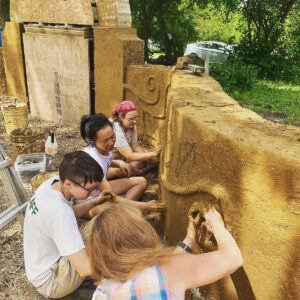
Our big project for the course was a naturally built garden wall and arch. This was an important piece to be working on, as it was at the entrance to Dancing Rabbit, which is the first thing people will see and thus, sets the tone for the whole community. Thus, we were really honored to be working on such a forward-facing project. Through this, we learned all of the basics of natural building: how to create a good footer that drains well, how to set and shape bales, and how to pin them together so that they are firm and don’t shift. We learned about sculpting the bales to create a smooth surface to start applying various earthen plasters and finished. We learned about structural cob and how to embed bottles and other things, and also how to create a range of plasters and mortars, including lime mortar, cob mortar, lime plaster, and cob plaster. There was so much good stuff jam-packed into four days! Obviously, it is outside of the scope of this post to share details about all of that–that’s why you should go to Dancing Rabbit and take the course!
Our instructors had made cob bricks (aka adobe bricks) prior to us coming and we used a lime mortar and this template to put it together. It was an amazing thing to experience–adding each of the adobe bricks and keeping them aligned as we watched the arch go up. And putting in the keystone, and having it stand!
One of the big takeaways for me from this project was working with lime. I have always been interested in lime–it is a much more permanent way of preserving things but still within a natural building framework. In fact, since I’ve returned home, I finished my earth oven roof (which I’ll share details about soon!) and used a lime mortar to create some foundational pieces for the structure.
The Intangibles: Confidence and Connection
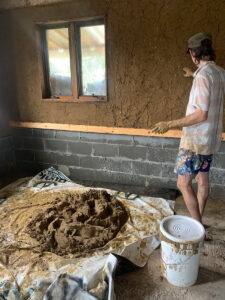
As a woman living in a very conservative area, there are still strong ideas about men’s work and women’s work. I’ve had a difficult time in learning the skills I want to learn to be an effective homesteader (chainsaw, construction, basic tool use) because people who know these skills where I live aren’t very willing to teach them to someone like me. There’s also this entire body of knowledge about fixing things, tools, etc, that were simply not available to me. There are very few women that I know–literally none locally–who know these skills who I could ask to teach me. Even when I go to the hardware store to get something, I’m met with disdain and dismissal. I hadn’t realized how much of this disempowerment I had internalized, and how much of it came up for me when I was at my natural building course. Another woman in the course had just gotten out of a long-term marriage where she also experienced similar disempowerment, and we shared our stories and pledged to not let the overriding gender norms impact our ability to be empowered and grow. It was fun to do the course by her side and to see both of us working to overcome literally a lifetime of men telling us we couldn’t build things.
I must say, because of these concerns, I had been procrastinating finishing my earth oven shelter prior to my course–the oven itself was a straightforward project, but the shelter deeply intimidated me for the reasons above–I felt I lacked the skills, knowledge, and confidence to take it on, particularly using wood I had harvested from the land (that was, of course, not entirely straight or even). But after returning from the course, I jumped into the project. I talked through aspects of the project when I was at the course, and I drew up a design that was workable. With help from a friend for putting up the structure itself, I otherwise was able to complete the whole thing on my own. It looks super cool and quirky. It’s not perfect but it showed me that I can really accomplish anything I want to do–and the worst that can happen is that I make a mistake and grow from the experience.
That’s a lesson that was only taught to me because of the deeply supportive nature of the course. One of the things I really liked that we did each day was morning check-in and morning stretching. We would stand in a circle and go around, with each of us being able to share where we were at good things, or things that we were struggling with. The group had a deep level of respect for each other and we created a container to share some of those deep vulnerabilities. It really set the tone of growth and working to push one’s edge, and for that, I am grateful. I’m not sure I would have been able to dig into some of this stuff I’m writing about here without it.
Conclusion
My time at Dancing Rabbit for the natural building course was really life-changing, affirming, generative, and wonderful. If I hadn’t had such strong connections to my land here (family, homestead, geese, job, love of my mountains), I’m not sure I would have ever left. The natural building course, led by Alis and Mark, was an incredibly transformational experience for me, and one that has deeply impacted me in the months since I was able to take it. Not only did I learn the skills that I signed up to learn, I learned a good deal about myself and tackled some long-standing challenges, I learned the power of community, and I was inspired to see different ways of living fully and meaningfully despite the challenges of our age. I cannot recommend a visit to Dancing Rabbit tightly enough. They have many different kinds of courses that may interest you–and I think it is well worth your time.

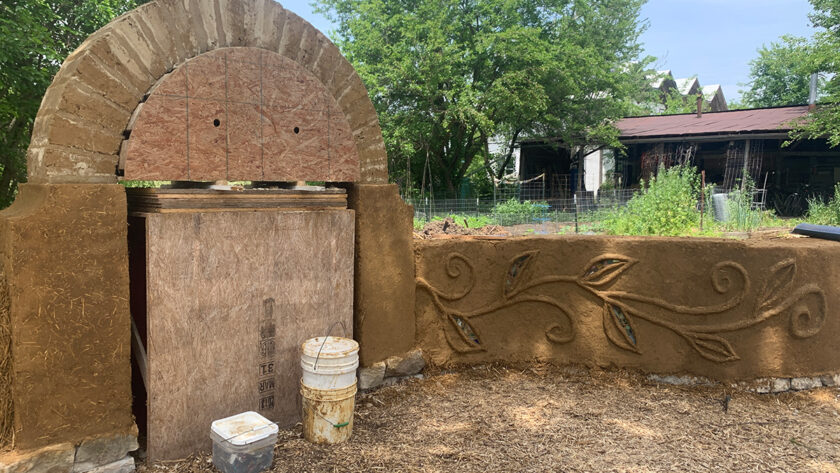
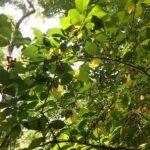

I’ve really enjoyed all your articles. One of these days, Dancing Rabbit for me. I have high affinity for this sort of thing. Learning/doing. The tree articles have been my favorite tho:) I swear I can feel them, especially when they are traumatized!
Hi Avacalla, I’m glad you resonate with the articles! I love trees–there will be more posts to come :). I just finished up the TreeLore Oracle so I’m taking a break for a while till I start some more :).
It sounds like we need more Dancing Rabbit villages! Friends of mine live in a passive solar cob-strawbale house with a post-and-beam frame, so the strawbales aren’t taking the weight. It took some years of building and rebuilding to get it to the point of livability and was certainly a series of experiments. I think I did spend a day or two plastering clay onto straw with them. It’s now quite comfortable and has most of the usual indoor amenities (admittedly fossil fuel-driven), like a gas stove and a refrigerator, but it’s still heated with a woodstove. Once they went on vacation in the dead of winter and the fire was out for a week, but the interior temperature never went below 40 degrees and they had no frozen pipes, although it was below zero outside. (The downside was that it took days to warm the place up again.) If I were considering new construction, I would definitely want a passive solar design. I’m so glad you had a chance to experience this and learn these techniques!
Hi Karen,
Your friend’s house sounds pretty incredible. These are such learning experiences….it takes a while to get them right. Strawbale can be loadbearing if it is compressed, but compressions can be difficult. We saw some good and bad examples of this at Dancing Rabbit! Blessings 🙂